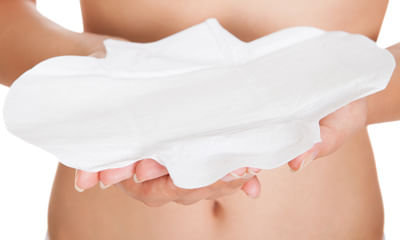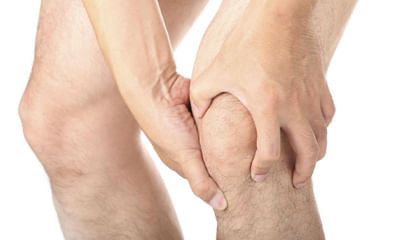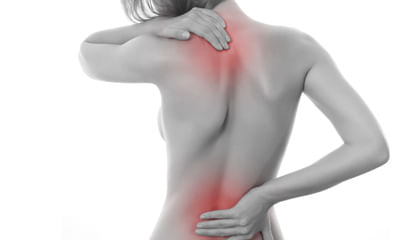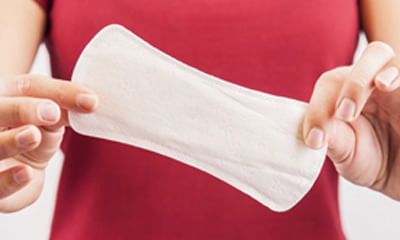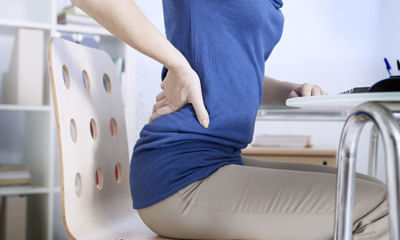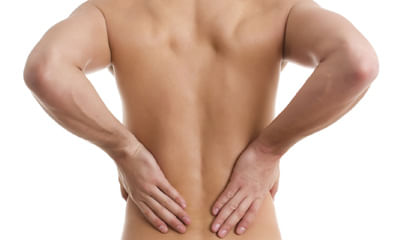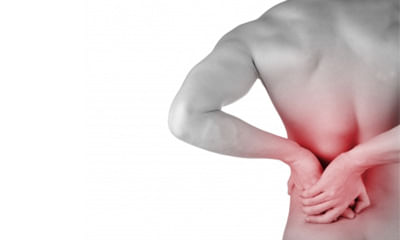Period Pains In Thighs
Every month before or after periods my left upper back thigh hurts badly. The pain last for 2-3 days. ...
Ask Free Question
Hi, lybrate user, Tk, plenty of water to hydrate yourself ,to eliminate toxins ,nourishing your body ,establishing your normal flow. • Go for meditation to reduce your stress,anxiety to calm your nerve easing your stress in order to improve haemoglobin level. • your diet be simple,non- irritant,easily digestible on time to maintain your digestion,avoiding gastric disorder, minimising cramp abdomen •Tk,Apple,carrots,cheese,milk,banana,papaya, pomegranate,spinach,almonds,walnuts to feel energetic improving haemoglobin level. •Consult ,privetly for a faster recovery, till, then take, homoeopathic medicine, underlying: @Sepia 30ch-5 drops ,thrice , orally, daily. •Ensure,sound sleep in the night for at least 7 hrs..• Avoid,caffiene,junk food,dust,smoke,exertion Tk,care,
My knee hurts a lot. It has been five years. What is the solution to this? I have been prescribed voveran sr 75 tablets ...
Ask Free Question
Will need to evaluate by physical examination and diagnostic imaging like x rays/mri / blood tests. We may need to aspirate the joint if swelling is associated with pain. We need to find out the cause of pain. Do not consume painkillers for prolonged duration since it has its own side effects. Consult an orthopaedic surgeon.
Hello! i'm 22 years old. I've this strange venous problem in my legs. I get extreme pain in legs during summers. I have ...
Ask Free Question
Compression wearing compression stockings is vital for preventing and treating varicose veins. They steadily squeeze your legs to help improve your circulation. They may also help to relieve pain, discomfort or swelling in your legs. Walking just walk more. It’s a great way to encourage blood circulation in your legs. Pedaling lie flat on your back. Place your hands out to your sides. If you prefer you can place them beneath your buttocks to prevent strain to the lower back. Lift your legs off the floor, and pedal them as if you were pedaling a bicycle. The more you elevate your legs, the more you will increase blood circulation. Leg lifts lie on your back with your hands beneath your buttocks. Keep your buttocks pressed down, and your lower back against the floor. Lift one leg at a time and hold in an elevated pose perpendicular to the floor until you feel the blood begin to flow back up from your feet, calves, and thighs. Repeat with your other leg. Alternately, you can raise both legs and rotate your ankles to further improve leg circulation. Knee bends with ankle flexion lie again on the floor on your back. Slowly pull one knee into your chest, holding onto your leg behind your knee (holding on top of the kneecap puts undue pressure on this delicate joint). Now, point and flex your foot several times. Do this slowly and forcefully – don’t let your foot flap around loosely, but rather tighten the muscles of the calves and the tendons around your ankle. Repeat with the opposite leg. The same measures to treat the discomfort from varicose veins can help prevent them: •watching your weight; •a high-fiber, low-salt diet; •avoiding high heels and tight hosiery; •elevating your legs; •avoid crossing your legs; •changing your sitting or standing position regularly.
Hi, I have taken primolut n 5g, twice a day for 23 days. I finished taking the medication on the 17 but started bleeding ...
Ask Free Question
Kindly consult gynaecologist .here some exercises that may help you to get rid of your period cramps butterfly stretch 1.Sit on the ground, bend your legs, and bring the soles of your feet together so they touch, letting your knees fall out to the sides. 2.Bring your heels as close to your body as you can and lean forward into the stretch, using your elbows to gently push your knees toward the ground. Kneeling adductor stretch keep your adductors — the muscles on the inside of your thigh — loose with this stretch. How to: start on the ground on your hands and knees. Kick one leg out to the side with your knee straight. Plant the foot flat with your toes pointing forward. Keep your weight on the knee of the bent leg. Rock your butt back toward the foot of the bent leg, keeping the leg to the side straight. If you can comfortably rock your butt all the way back, reach toward the straight leg with the arm of the same side. •how to do kegel ex’s ••find the right muscles. To identify your pelvic floor muscles, stop urination in midstream or tighten the muscles that keep you from passing gas. These maneuvers use your pelvic floor muscles. Once you've identified your pelvic floor muscles, you can do the exercises in any position, although you might find it easiest to do them lying down at first. •perfect your technique. Tighten your pelvic floor muscles, hold the contraction for three seconds, and then relax for three seconds. Try it a few times in a row. When your muscles get stronger, try doing kegel exercises while sitting, standing or walking. •maintain your focus. For best results, focus on tightening only your pelvic floor muscles. Be careful not to flex the muscles in your abdomen, thighs or buttocks. Avoid holding your breath. Instead, breathe freely during the exercises. •repeat 3 times a day. Aim for at least three sets of 10 repetitions a day. Don't make a habit of using kegel exercises to start and stop your urine stream. Some doctors think this could cause a bladder infection.
This is my 2nd missed period my tests are showing negative along with a negative scan result, I have a pain in my pelvis ...
Ask Free Question
Missed period may be due to hormonal imbalance so go for t3t4 tsh, fsh ,lh, prolactin, testosterone and for bodyache go for re urine and urine c/s because may be e.coli.
My lower back was paining from last 20 days. My foot slipped and I fall down. My pain is now radiating to my right leg. ...
Ask Free Question
Adjust your eating routine. Try to eat when you have good muscle strength. Take your time chewing your food, and take a break between bites of food. You might find it easier to eat small meals several times a day. Also, try eating mainly soft foods and avoid foods that require more chewing, such as raw fruits or vegetables. Use safety precautions at home. Install grab bars or railings in places where you need support, such as next to the bathtub or next to steps. Keep your floors clean, and move area rugs. Outside your home, keep paths, sidewalks and driveways cleared of leaves, snow and other debris that could cause you to stumble. Use electric appliances and power tools. To help you maintain your energy, try using an electric toothbrush, electric can openers and other electrical tools to perform tasks. Wear an eye patch. If you have double vision, an eye patch can help relieve the problem. Try wearing one to write, read or watch television. Periodically switch the eye patch to the other eye to help reduce eyestrain. Plan if you have chores, shopping or errands to do, plan the activity for when you have the most energy. Palpitation of the heart please consult a physician and he will help you further to consult a cardiologist. I feel you have arrhythmia which might be the heart palpitation which is not good. Consume lot of water and take good rest in the initial days / weeks until you consult the doctor. Please take care and let us know whether you have progressed. Posture supportspoor sitting posture is a common cause of sciatica. To assist the support of your lower back many simple and effective products have been developed over time. These include: lumbar d-roll bassett frame kinesiology lumbar tape please ask your physiotherapist for their advice in what will help you most. Exercise sciatic nerve pain 1. Reclining pigeon posepigeon pose is a common yoga pose. It works to open the hips. There are multiple versions of this stretch. The first is a starting version known as the reclining pigeon pose. If you are just starting your treatment, you should try the reclining pose first. 1.While on your back, bring your right leg up to a right angle. Clasp both hands behind the thigh, locking your fingers. 2.Lift your left leg and place your right on top of the left knee. 3.Hold the position for a moment. This helps stretch the tiny piriformis muscle, which sometimes becomes inflamed and presses against the sciatic nerve, causing pain. 4.Do the same exercise with the other leg. Once you can do the reclining version without pain, work with your physical therapist on the sitting and forward versions of pigeon pose. 2. Sitting pigeon pose 1.Sit on the floor with your legs stretched out straight in front of you. 2.Bend your right leg, putting your right ankle on top of the left knee. 3.Lean forward and allow your upper body to reach toward your thigh. 4.Hold for 15 to 30 seconds. This stretches the glutes and lower back. 5.Repeat on the other side. 3. Forward pigeon pose 1.Kneel on the floor on all fours. 2.Pick up your right leg and move it forward on the ground in front of your body. Your lower leg should be on the ground, horizontal to the body. Your right foot should be in front of your right knee while your right knee stays to the right. 3.Stretch the left leg out all the way behind you on the floor, with the top of the foot on the ground and toes pointing back. 4.Shift your body weight gradually from your arms to your legs so that your legs are supporting your weight. Sit up straight with your hands on either side of your legs. 5.Take a deep breath. While exhaling, lean your upper body forward over your front leg. Support your weight with your arms as much as possible. 6.Repeat on the other side. 7.4. Knee to opposite shoulder this simple stretch helps relieve sciatica pain by loosening your gluteal and piriformis muscles, which can become inflamed and press against the sciatic nerve. 1.Lie on your back with your legs extended and your feet flexed upward. 2.Bend your right leg and clasp your hands around the knee. 3.Gently pull your right leg ac 4.5.6.7.Ross your body toward your left shoulder. Hold it there for 30 seconds. Remember to pull your knee only as far as it will comfortably go. You should feel a relieving stretch in your muscle, not pain. 8.Push your knee so your leg returns to its starting position. 9.Repeat for a total of 3 reps, and then switch legs. 5.sitting spinal stretch sciatica pain is triggered when vertebrae in the spine compress. This stretch helps create space in the spine to relieve pressure on the sciatic nerve. 1.Sit on the ground with your legs extended straight out with your feet flexed upward. 2.Bend your right knee and place your foot flat on the floor on the outside of your opposite knee. 3.Place your left elbow on the outside of your right knee to help you gently turn your body toward the right. 4.Hold for 30 seconds and repeat three times, then switch sides. 6. Standing hamstring stretch this stretch can help ease pain and tightness in the hamstring caused by sciatica. 1.Place your right foot on an elevated surface at or below your hip level. This could be a chair, ottoman, or step on a staircase. Flex your foot so your toes and leg are straight. If your knee tends to hyperextend, keep a slight bend in it. 2.Bend your body forward slightly toward your foot. The further you go, the deeper the stretch. Do not push so far that you feel pain. 3.Release the hip of your raised leg downward as opposed to lifting it up. If you need help easing your hip down, loop a yoga strap or long exercise band over your right thigh and under your left foot. 4.Hold for at least 30 seconds, and then repeat on the other sideif you have low back pain and sciatica you can undergo intermittent pelvic traction where in your half of your body weight will be added in the electronic traction so that that would help you to reduce the pain, along with interferential therapy stimulations which would help you to get relieved from the radiating pain. Apply ice for the pain to get subsided immediately. If you cannot go immediately for the physiotherapy treatment. Ice can be kept in the low back where you have back pain. It is suggestible to wear lumbo sacral belt which would help you to build the abdominal muscle tone which itself would make you feel better. You can also wear mcr chappals which would help you to have less weight falling in the painful back.
Am 29 years old and am having backache problems, I also frequently urinate, and my sex life is poor. ...
Ask Free Question
Adjust your eating routine. Try to eat when you have good muscle strength. Take your time chewing your food, and take a break between bites of food. You might find it easier to eat small meals several times a day. Also, try eating mainly soft foods and avoid foods that require more chewing, such as raw fruits or vegetables. Use safety precautions at home. Install grab bars or railings in places where you need support, such as next to the bathtub or next to steps. Keep your floors clean, and move area rugs. Outside your home, keep paths, sidewalks and driveways cleared of leaves, snow and other debris that could cause you to stumble. Use electric appliances and power tools. To help you maintain your energy, try using an electric toothbrush, electric can openers and other electrical tools to perform tasks. Wear an eye patch. If you have double vision, an eye patch can help relieve the problem. Try wearing one to write, read or watch television. Periodically switch the eye patch to the other eye to help reduce eyestrain. Plan if you have chores, shopping or errands to do, plan the activity for when you have the most energy. Palpitation of the heart please consult a physician and he will help you further to consult a cardiologist. I feel you have arrhythmia which might be the heart palpitation which is not good. Consume lot of water and take good rest in the initial days / weeks until you consult the doctor. Please take care and let us know whether you have progressed. Posture supportspoor sitting posture is a common cause of sciatica. To assist the support of your lower back many simple and effective products have been developed over time. These include: lumbar d-roll bassett frame kinesiology lumbar tape please ask your physiotherapist for their advice in what will help you most. Exercise sciatic nerve pain 1. Reclining pigeon posepigeon pose is a common yoga pose. It works to open the hips. There are multiple versions of this stretch. The first is a starting version known as the reclining pigeon pose. If you are just starting your treatment, you should try the reclining pose first. 1.While on your back, bring your right leg up to a right angle. Clasp both hands behind the thigh, locking your fingers. 2.Lift your left leg and place your right on top of the left knee. 3.Hold the position for a moment. This helps stretch the tiny piriformis muscle, which sometimes becomes inflamed and presses against the sciatic nerve, causing pain. 4.Do the same exercise with the other leg. Once you can do the reclining version without pain, work with your physical therapist on the sitting and forward versions of pigeon pose. 2. Sitting pigeon pose 1.Sit on the floor with your legs stretched out straight in front of you. 2.Bend your right leg, putting your right ankle on top of the left knee. 3.Lean forward and allow your upper body to reach toward your thigh. 4.Hold for 15 to 30 seconds. This stretches the glutes and lower back. 5.Repeat on the other side. 3. Forward pigeon pose 1.Kneel on the floor on all fours. 2.Pick up your right leg and move it forward on the ground in front of your body. Your lower leg should be on the ground, horizontal to the body. Your right foot should be in front of your right knee while your right knee stays to the right. 3.Stretch the left leg out all the way behind you on the floor, with the top of the foot on the ground and toes pointing back. 4.Shift your body weight gradually from your arms to your legs so that your legs are supporting your weight. Sit up straight with your hands on either side of your legs. 5.Take a deep breath. While exhaling, lean your upper body forward over your front leg. Support your weight with your arms as much as possible. 6.Repeat on the other side. 7.4. Knee to opposite shoulder this simple stretch helps relieve sciatica pain by loosening your gluteal and piriformis muscles, which can become inflamed and press against the sciatic nerve. 1.Lie on your back with your legs extended and your feet flexed upward. 2.Bend your right leg and clasp your hands around the knee. 3.Gently pull your right leg ac 4.5.6.7.Ross your body toward your left shoulder. Hold it there for 30 seconds. Remember to pull your knee only as far as it will comfortably go. You should feel a relieving stretch in your muscle, not pain. 8.Push your knee so your leg returns to its starting position. 9.Repeat for a total of 3 reps, and then switch legs. 5.sitting spinal stretch sciatica pain is triggered when vertebrae in the spine compress. This stretch helps create space in the spine to relieve pressure on the sciatic nerve. 1.Sit on the ground with your legs extended straight out with your feet flexed upward. 2.Bend your right knee and place your foot flat on the floor on the outside of your opposite knee. 3.Place your left elbow on the outside of your right knee to help you gently turn your body toward the right. 4.Hold for 30 seconds and repeat three times, then switch sides. 6. Standing hamstring stretch this stretch can help ease pain and tightness in the hamstring caused by sciatica. 1.Place your right foot on an elevated surface at or below your hip level. This could be a chair, ottoman, or step on a staircase. Flex your foot so your toes and leg are straight. If your knee tends to hyperextend, keep a slight bend in it. 2.Bend your body forward slightly toward your foot. The further you go, the deeper the stretch. Do not push so far that you feel pain. 3.Release the hip of your raised leg downward as opposed to lifting it up. If you need help easing your hip down, loop a yoga strap or long exercise band over your right thigh and under your left foot. 4.Hold for at least 30 seconds, and then repeat on the other sideif you have low back pain and sciatica you can undergo intermittent pelvic traction where in your half of your body weight will be added in the electronic traction so that that would help you to reduce the pain, along with interferential therapy stimulations which would help you to get relieved from the radiating pain. Apply ice for the pain to get subsided immediately. If you cannot go immediately for the physiotherapy treatment. Ice can be kept in the low back where you have back pain. It is suggestible to wear lumbo sacral belt which would help you to build the abdominal muscle tone which itself would make you feel better. You can also wear mcr chappals which would help you to have less weight falling in the painful back. U have to take vitamin d rich foods. Likemilk,cheese, yogurt,brocoli, spinach.u need calcium consumption for increase the bone density. Lackof bone and bones crush inside the body this might be due to low calcium or vitamin d which has more impact on the bone density and also it makes one to feel that there is lack of bone strength or in a way the bones are brittle and almost breaking and they feel it is crushed in a way there are many bones breaking at the same time. You have to take vitamin d rich foods. Likemilk,cheese, yogurt, brocoli, spinach.u need calcium consumption for increase the bone density. vitamin d intake via supplements or exposure to low levels of sunlight. Vitamin d is used to absorb calcium in the bone and regulate calcium in the blood.
Hello doctor! i'm 22 years old and on my first day of periods I got severe pain in uterus, lower back and only in right ...
Ask Free Question
Hi, Lybrate user, •it so happens in dysmenorrhoea, you are suffering from ,carrying weakness in general, lowering your suger and bp level, down.• tk, plenty of water to hydrate yourself ,to eliminate toxins ,nourishing your body ,establishing your normal flow. • go for meditation to reduce your stress, anxiety to calm your nerve easing your stress in order to improve haemoglobin level. • your diet be simple, non- irritant, easily digestible on time to maintain your digestion, avoiding gastric disorder, minimising cramp abdomen •tk, apple,carrots, cheese,milk, banana,papaya, pomegranate, spinach,almonds, walnuts to feel energetic improving haemoglobin level. •consult ,privetly for a faster recovery, till, then take, homoeopathic medicine, underlying: @ sepia30ch-5 drops ,thrice.•ensure, sound sleep in the night for at least 7 hrs.• avoid, caffiene,junk food, dust,smoke, exertion tk, care,
Hello all doctor I am 38 years of male last year I had done mri ok spine it shows it shows d 6 and d7 space loss I am ha ...
Ask Free Question
Do’s and don’ts for neck pain: do’s •do turn to one side while getting up from supine position. •use hot pack for your neck. •use towel roll under the neck during supine lying. •use pillow of normal thickness in side lying position. •do isometrics for neck. •arms should be supported in one of the three positions:•™ hands in pocket ™ •hands on thighs/or on table. •™ hand behind back with elbow straight. •in order to avoid holding the head in the same position for long periods, take break while driving, watching tv or working on a computer. •use a seat belt when in a car. •use cervical collar in case of giddiness. •retraction of shoulders every hour: move shoulders backward. Don’t’s •don’t sleep straight. •don t’ bend your neck. •avoid hanging of arms. •avoid sitting sitting for prolonged prolonged period of time in stressful stressful postures postures. •do not lift heavy weights on head or back. •do not drive for long hours; take breaks. •avoid habit of holding the telephone on one shoulder and leaning at it for long time. •do not take many pillows below the neck and shoulder while sleeping, •in order to turn around, do not twist your neck or the body; instead turn around by moving your feet first. Many people experience neck pain because of poor posture and muscle strain. In these cases, your neck pain should go away if you practice good posture and rest your neck muscles when they’re sore. The most common types of mild to moderate neck pain usually respond well to self-care within two or three weeks. If you have minor neck pain or stiffness, take these simple steps to relieve it: apply ice for the first few days. After that, apply heat with a heating pad, hot compress, or by taking a hot shower. Exercise your neck every day. Slowly stretch your head in side-to-side and up-and-down motions. Use good posture. Avoid cradling the phone between your neck and shoulder. Change your position often. Don’t stand or sit in one position for too long. Get a gentle neck massage. Use a special neck pillow for sleeping. Short-term immobilization. Use a soft collar that supports your neck may help relieve pain by taking pressure off the structures in your neck. However, if used for more than three hours at a time or for more than one to two weeks, a collar might do more harm than good. Forward and backward tilt this can be done while you're seated or on your feet. Keep your moves slow and smooth. Start with your head squarely over your shoulders and your back straight. Lower your chin toward your chest and hold for 15-30 seconds. Relax, and slowly lift your head back up. Tilt your chin up toward the ceiling and bring the base of your skull toward your back. Hold for 10 seconds, then return to the start position. Repeat the set several times. Do it every day. Side tilt do this while standing, with your feet hip-width apart and arms down by your sides. Gently tilt your head toward your right shoulder and try to touch it with your ear. Stop when you feel the stretch. Don't raise your shoulder. Hold the stretch for 5-10 seconds, then return to the start position. Repeat on your left side. You can do several sets and work your way up to 10 repetitions. For extra stretch, put the hand on the same side of your tilted head on top of your head, and press lightly with your fingertips. Side rotation you can do this while seated or standing. Keep your head squarely over your shoulders and your back straight. Slowly turn your head to the right until you feel a stretch in the side of your neck and shoulder. Hold the stretch for 15-30 seconds, and then slowly turn your head forward again. Repeat on your left side. Do up to 10 sets. Press your palm against your forehead. Resist with your neck muscles. Hold for 10 seconds. Relax. Repeat 5 times. Do the exercise again, pressing on the sides (both the sides (right & left side) of your head. Repeat 5 times. Switch sides. Do the exercise again, pressing on the back of your head. Repeat 5 times.Hot or cold compresses. Applying heat or cold may help. "some people like heat, some like cold, deal says. "whatever feels best. Tens (transcutaneous electrical nerve stimulation). A tens system includes a small, battery-powered machine, connected by wires to a pair of electrodes. The electrodes are connected to your skinnear the pain source. A mild electrical current travels through your skin and goes along your nerve fibers. It may reduce pain by changing the way your brain perceives pain, experts say. One session takes about 15 minutes. "tens is sometimes helpful -- not a game-changer but worth a try, deal says. Massage. This may give your muscles relief. Get your doctor's approval first, only get massage from a qualified therapist, and make sure the therapist knows about your osteoporosis and your fracture. Osteoporosis exerciseexercisingregularlybuildsandstrengthensbones. Weight-bearingexercises—wherebonesandmusclesworkagainstgravity—arebest. Theseincludeaerobics,dancing, jogging,stairclimbing, tennis,walking, andliftingweights.peoplewhohaveosteoporosismaywant to attemptgentleexercise, such as walking, ratherthanjogging or fast-pacedaerobics, whichincreasethechance of falling. Exercisingthree to fourtimesperweekfor 20-30 minuteseachtimehelps. Osteoporosis treatmentthe treatment of osteoporosis involves reducing any of the factors contributing to poor bone health. Yosur doctor may advise you to address current exercise regime, review your medications or review current lifestyle factors that predispose you to osteoporosis. Your doctor may also advise you to increase your: calcium intake via your diet or with supplements. Calcium is used to build and maintain bone health. vitamin d intake via supplements or exposure to low levels of sunlight. Vitamin d is used to absorb calcium in the bone and regulate calcium in the blood. Tips for osteoporosisweight bearing exercise, such as walking, can help to strengthen bonesexercises to improve your balance and strength will help to prevent falls follow a healthy diet that includes enough calcium and vitamin duse this handy calculator to make sure you are getting enough calcium. Wear sensible, well-fitting shoes to avoid fallsavoid rugs and sloppy slippers – both can cause tripshave good lighting on your stairsget your eyesight checked regularly (free for people over 60) try to avoid heavy lifting – consider home delivery grocery shoppingthis is a general low back ache and for this you can follow these measures: one keep a pillow right under the knee while sleeping, next is you can keep ice in the painful area for about 5--10 minutes, if pain still persists you can stretch your body by twisting the waist on both sides how we used to do in the school drill similarly you can try which will help you relax as well will reduce the pain.
In my periods I have pain in both upper and lower abdomen. I feel heavy in upper abdomen, I think it is due to gas forma ...
Ask Free Question
What r other symptoms that you r experiencing? By doing what like walking, exertion, eating or empty stomach- it increases or decreases in intensity. For how much time the pain remains? Is there stiffness also? How is your appetite? R you constipated? Any problem in urine? I need details of case. In the meanwhile follow this 1. Don't take tea empty stomach. Eat something like a banana (if you are not diabetic) or any seasonal fruit or soaked almonds and a glass of water first thing in the morning (within 10 mins of waking up). No only biscuits or rusk will not do. 2. Don't overeat 3. Take your breakfast every day. Don't skip it. U should eat whatever your mother or grandparent eat in bfast. I mean to say whatever is your traditional food. If punjabi eat paratha, if belongs to south then take idli/ dosa etc. 4. Have light meals every 2 hours (in addition to your breakfast, lunch n dinner) e.g. Nariyal paani, chaach, a handful of dry fruits, a handful of peanuts, any fresh n seasonal fruit, a cup of curd/milk etc 5. Finish your dinner at least 2 hours before going to sleep. 6. Maintain active life style7. Avoid fast foods, spicy n fried foods, carbonated beverages 8. Take a lot of green vegetables n fruit. 9. Drink lot of water.10. Everyday preferably sleep on same time exercise in the form of yoga, cycling, swimming, gym etc. Till lockdown do suryanamaskar every day. Https://www.youtube.com/watch? V=wmhmazurgvsandfeature=youtu. Be for this homeopathy offers good results. Consult online with details.

